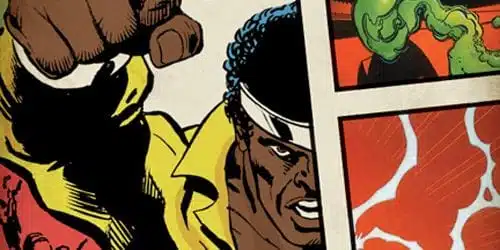
In 1979, Adam West and Burt Ward donned their capes and masks and returned to television as Batman and Robin in a two-part special called Legends of the Superheroes. The special included many additional DC heroes including Green Lantern, Flash, and Hawkman. The second episode featured a Dean Martin-style celebrity roast of DC’s very own “Rat Pack”.
The heroes were seated behind small podiums bearing their own logos, and a tuxedo-clad Ed McMahon served as emcee. (I wish I were making this up.) In one segment, McMahon noted that the superhero community did not include many “minorities”, but perhaps that was about to change. And with that, he introduced “Ghetto Man”.
In the segment, “Ghetto Man” turns out to be an African-American character dressed in a jeweled vest and fringe pants, looking like a lost extra who accidentally wandered over from the set of Starsky and Hutch. Before strutting to the center stage, Ghetto Man and West’s Batman actually give each other “five” and do the “bump”.
Ghetto Man then delivers a stand up routine, making jokes about whether the NAACP would acknowledge Green Lantern as “colored”. Hawkman laughs so hard he looks like he’s trying to keep milk from squirting out of his beak.
The whole thing is nothing short of mortifying.
Luckily, with his engaging new book, Super Black: American Pop Culture and Black Superheroes, Adilifu Nama has provided us with the perfect antidote to the spectacle of Ghetto Man. As Nama explains, most critics haven’t paid much attention to black superheroes, and of those who have, far too many take the easy road and dismiss the characters as “updated racial stereotypes… or they are uncritically affixed to the Blaxploitation film craze as negative representations of blackness”. Nama wants to correct that problem.
In Super Black, Nama celebrates the tradition of black superheroes in comics, film, and television. Even though a contemporary eye can find both amusing and offensive stereotypes in many of these comics, compared to the nadir of Ghetto Man, they seem like they could have been written by Ralph Ellison.
Unlike many academics who write about comics, Nama knows the material well and his prose is quite readable. Super Black is largely a jargon-free zone, with Nama offering practical, pragmatic analysis of the role of race in mainstream superhero titles over the past 50 years. As a critic, he’s not afraid to insert personal memories and reflections when relevant, and he possesses a particular skill for making unexpected connections between the comic characters and the culture at large. For example, he makes a reasonably compelling case for viewing Cool Hand Luke as a direct antecedent for Luke Cage—a character often dismissed as one of those “dated” relics from the Blaxploitation era.
Even when Nama’s arguments are more strained, such as seeing I Spy as an influence on Captain America and the Falcon, or attempting to view the Avery Brooks character from A Man Called Hawk as part of the superhero tradition, the reader still appreciates the effort.
Nama also does a good job of balancing his time between the better known characters like the Black Panther, Luke Cage, and the Green Lantern John Stewart, and less iconic figures like Brother Voodoo. In fact, it’s a pretty safe bet that he devotes more space to discussing Marvel’s Cloak and Dagger than anyone ever has before.
On the other hand, Nama sometimes gives in to some fairly self-indulgent speculations. For example, after discussing Nubia, a largely forgotten black sister to Wonder Woman, he launches into a long hypothetical of what Nubia could have been had DC done more with her. The speculation feels forced, and his conclusion that DC abandoned Nubia because of the popularity of Storm, a member of the Marvel’s new X-Men team, feels like a rhetorical conceit.
Nama’s approach to the subject matter also produces some eccentricities. Since he’s more interested in the history of the characters, he sometimes dissects entire stories without acknowledging the writers or artists behind them. He also flirts with some particularly interesting ideas, such as the superhero-like depiction of President Obama in both comics and posters — but he only brings it up in the final three pages of the book, making what could have been a substantial part of a chapter feel like an afterthought.
Most frustrating is his inconsistent attention to context. When discussing older heroes like the Black Panther and Luke Cage from the ‘60s and ‘70s, he makes several connections to the larger political and social events of the day, but when so many of the black superheroes apparently disappear in the ‘80s, he fails to address their absence or whether the Reagan-era practice of ignoring racial inequality in America had any impact on their growing invisibility. Likewise, when many of the established black superheroes re-emerge in the ’90s, he offers few social or political explanations.
Despite Nama’s occasional missteps, however, the book still works. His enthusiasm is infectious and his discussions offer more than mere historical analysis. In an environment where many recent titles from DC have drawn fire for their exploitation of women, Super Black provides a pointed reminder of the importance and impact of identity and representation in comic books and is a welcome addition to the current critical conversation.
